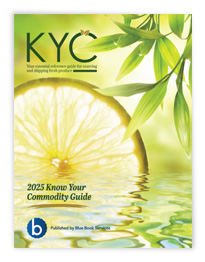Kiwifruit Market Summary

Image: Nitr/Shutterstock.com
Kiwifruit Market Overview
Kiwifruit, sometimes known as Chinese gooseberry, or simply “kiwi,” is thought to have been discovered in various regions of China and was considered a delicacy among royals. Seeds from China were introduced to New Zealand in the 1900s and were exported to the United States in the 1950s. The most common variety is a green kiwi, the Hayward, grown almost exclusively in California and originating from the first known plants exported from New Zealand. Green kiwis are fuzzy and brown with bright green flesh and tiny black seeds. The fruit grows on a woody vine that can reach up to 30 feet tall.
Types & Varieties of Kiwifruit
There are several types of kiwifruit: grocery store green kiwifruit (Actinidia deliciosa), yellow or gold kiwis (Actinidia chinensis), hardy kiwifruit (Actinidia arguta), and super-hardy kiwifruit (Actinidia kolomikta). Green kiwifruit is the most common but yellow kiwis are gaining popularity due to their smoother, edible skin. Hardy kiwifruit, known as “bowerberry,” grows on trees that can reach 100 feet tall in the forests of Japan, China, Korea, and Siberia, where they are able to withstand colder temperatures. The fruit is smooth-skinned, quite sweet, and grows in clusters like grapes. The super-hardy kiwi is also smooth-skinned with even smaller fruit and can handle temperatures to -40°F in winter. It is sometimes called the “arctic beauty kiwifruit.” There are more than forty known varieties of kiwi, spanning the globe from California to New Zealand to Greece, though the Hayward remains the standard for most commercial growers. In areas where there are growing limits due to colder temps, the Saanicheton variety has been known to survive where the Hayward has not. Other varieties include Elmwood, Dexter, Tewi, Vincent, Matua, Tomuri, Allison, Abbott Bruno, Gracie, and Monty.Cultivation of Kiwifruit
Kiwifruit can grow wherever citrus, peaches, and almonds are plentiful, but its leaves are more sensitive to cold than orange or peach trees. Young kiwifruit vines are killed by drops in temperature below 29°F, while mature vines can withstand temperatures below 10°F. For healthy growth, plants need deep, fertile, moist, and well-drained soil. Flowers of the plant are almost exclusively pollinated by insects. Kiwifruit is harvested by hand in a single pick once fruit has reached maturity.
Pests & Diseases Affecting Kiwifruit
Rootknot nematodes are parasitic worms that attack the roots of plants, causing “knots” to form. The leafroller caterpillar (the most common and damaging pest) will eat holes in the fruit causing scarring, especially where two or three fruits are touching each other. In summer or early fall, thrips can cause browning of the leaves. Greedy scale insects infest the leaves, bark, and fruit, killing the growth tips. The boxelder bug tends to feed on the buds and fruit, causing deformities and fruit drop. Crown gall affects vines and can be avoided by leaving the upper roots exposed. Roots can also be attacked by phytophthora cactorum and P. cinnamomi, along with oak root fungus, which cause root rot, killing the entire plant. Botrytis cinerea affects both the flowers and the fruit and has been found in most growing areas. The biggest threat to kiwis is postharvest grey mold rot, which enters the skin through small cracks when stored at high humidity. Kiwifruit vine disease (more common in Europe) is a bacterial cancer that causes halo-shaped spots on leaves, brown discoloration of buds, and release of a red-colored gum on the plant. The disease is spread through windborne pollen, heavy rainfalls, humans, and animals, and is most apparent during cooler temperatures and high humidity.Storage & Packaging of Kiwifruit
They are packed in single-layer flats, with some fruit being placed in small consumer bags. Kiwifruit should be stored at 32°F with 90 to 95% relative humidity. Freezing injury can occur in colder temperatures. Fruit is extremely susceptible to the effects of ethylene; use of controlled-atmosphere storage facilities is helpful for long-term storage to avoid its own production of the gas. References: California Kiwifruit Commission, California Rare Fruit Growers, New Zealand Ministry for Primary Industries, Oregon State University, Purdue University, UC Davis Integrated Pest Management, UC Davis Postharvest Technology Center, University of Arkansas, USDA.
Grades & Good Arrival of Kiwifruit
Kiwifruit is categorized as U.S. Fancy, U.S. No. 1, and U.S. No. 2. All require fruit to have similar varietal characteristics, be mature, not soft, overripe, or shriveled, and to be carefully packed. For U.S. Fancy, the fruit must also be clean and well-formed. All three grades stipulate fruit be free from worm holes, broken unhealed skin, sunscald, freezing injury, internal breakdown, and decay.
Generally speaking, the percentage of defects shown on a timely government inspection certificate should not exceed the percentage of allowable defects, provided: (1) transportation conditions were normal; (2) the USDA or CFIA inspection was timely; and (3) the entire lot was inspected.
| U.S. Grade Standards | Days Since Shipment | % of Defects Allowed | Optimum Transit Temp. (°F) |
| 12-6-2 | 5 4 3 2 1 | 15-8-3 14-8-3 13-7-2 13-6-2 12-6-2 | 32° |
Inspector's Insights for Kiwifruit
- Bruising is scored as a defect against the U.S. No. 1 grade if causing a slight discoloration and exceeding an area of 3/8-inch in diameter; or if there’s an indentation or discoloration deeper than 1/8 inch
- In storage moisture may evaporate, leading to shriveling; shriveling found on shoulders or stems is scored as a defect against the U.S. No. 1 grade if it exceeds 10% of the surface; shriveling is always scored against the tolerance for serious damage
- Kiwifruit has a maturity requirement for the U.S. No. 1 grade; soluble solids taken from 15 randomly selected fruit must meet a minimum of 6.5% brix.
Kiwifruit Retail Pricing: Conventional & Organic



